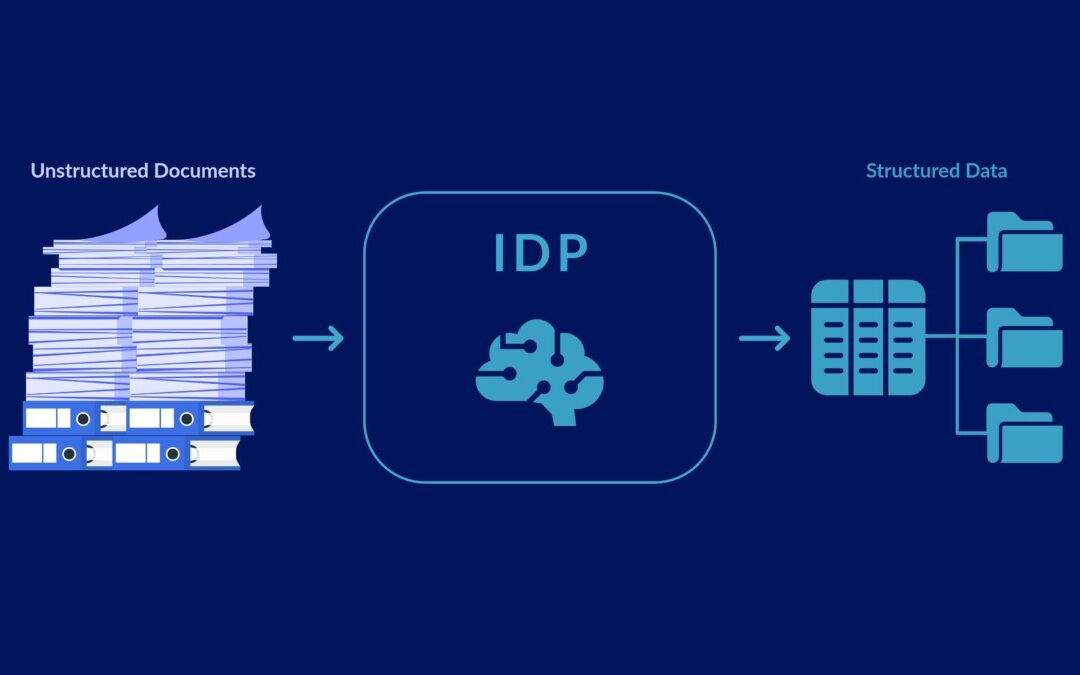The advantages of intelligent document processing just went beyond time and money savings. It also accelerates and improves the accuracy of the entire document processing process. Increased productivity, quicker document retrieval, greater accuracy, less manual work, improved process efficiency, automated document classification, and many other advantages are provided by intelligent document processing.
We’ll look at the main advantages of using an Intelligent Document Processing tool in this blog post, including how it may help businesses extract data from unstructured documents. However, let’s first define what intelligent document processing (IDP) is.
What is Intelligent Document Processing (IDP)?
The process of evaluating, extracting, and transforming data from unstructured documents is known as intelligent document processing (IDP). It is a crucial component of every corporation or organization that conducts business using documents.
Data extraction, analysis, optical character recognition (OCR), and document scanning are all steps in the process.
IDP is significant because there are numerous applications for it. It can be used to provide document classification, data extraction, and document conversion services that are automated.
IDP is crucial since it allows for automating tasks that would otherwise need manual labor. Additionally, Intelligent Document Processing is significant because it can automatically extract data from a batch of documents using machine learning and natural language processing techniques.
Furthermore, it aids in the decision-making process within enterprises, enabling them to save time and money while enhancing accuracy, compliance, and efficiency.
Now, look at the top benefits of intelligent document processing businesses can use to extract data from unstructured documents.
10 Advantages of Using an Intelligent Document Processing Tool
For businesses, document processing can be a very effective tool. It can streamline procedures, automate some jobs, and enhance document quality. A few advantages of using an Intelligent Document Processing Tool are mentioned below:
- Increased Productivity
IDP is a cutting-edge piece of software that can assist businesses in boosting efficiency and cutting down on time spent on routine chores. Although document processing takes time, it allows managers to automate laborious processes like data entry and record maintenance. In businesses, productivity can be increased by reducing time spent on routine tasks.
- Faster Document Retrieval
IDP offers a way to classify, cluster, and link the extracted information with other pertinent literature after automatically detecting and extracting textual content from documents.
This makes it simpler to locate relevant data among thousands of papers and automate processes typically done manually (e.g., document classification).
- Increased accuracy
Other advantages include increased and more accurate data retrieval. The documents can also be digitally signed or encrypted using this technique, ensuring they cannot be changed or tampered with.
Using IDP solutions to automate data extraction will improve the extracted data’s correctness and reduce errors, improving document retrieval accuracy and freeing up staff members’ time to make wise business decisions.
- Reduced Manual Effort
IDP has long been considered a method of minimizing human labor. The most recent advancements in AI can process documents by taking text from an image, voice, or video and extracting information from it. Natural language processing (NLP) is typically used, allowing the AI to read and comprehend a document’s content rather than just interpreting it as code.
One of the biggest advantages of using an Intelligent Document Processing Tool is the potential to do away with human intervention, giving staff more time to concentrate on important creative tasks.
- Improved Processes Efficiency
IDP can contribute to process improvement. It can do away with the necessity for manual data entry and establish an efficient workflow across several departments. This could help an organization save time, cut costs, and make more money.
Manual data entry is a laborious process that can take a worker many minutes to complete. With IDP technologies, this procedure may be automated and finished in a matter of seconds, speeding up the process and improving efficiency.
- Automated Document Classification
One of the key advantages of intelligent document processing is the capacity to classify documents automatically and produce separate categories that will help organizations organize their document collection without the need for human participation.
Any document management plan that is put into practice must include the practice of automatic document classification.
- Enhanced Compliance
Extracting data from documents and categorizing them by predetermined criteria can assist firms in automating and streamlining their compliance operations. Doing so can ensure compliance-related data is regularly and accurately recorded while reducing the time and expense involved with manual data entry and document review.
Furthermore, IDP can assist in developing a searchable database of compliance-related data that may be utilized for auditing or other functions. It can automatically identify sensitive information and respond with great accuracy depending on the circumstances surrounding how to handle such information. To adhere to numerous norms and regulations, sensitive information must be protected in all enterprises.
- Process Large Volumes of Documents
One of the main advantages of intelligent document processing is the ability to process massive numbers of documents quickly. You might regularly deal with a sizable quantity of documents depending on the size of your company. You would spend time and money if you went through the documents individually.
Your company would surely benefit from investing in an IDP solution and saving money while processing huge volumes of papers.
- Enhanced Security
By lowering the possibility of human mistakes and enabling better document monitoring and management, IDP can increase security. Documents can be accessed in various ways after they have been scanned, including by connecting to a document management system, which helps shield tax data from unwanted access.
There are more and more techniques to increase security as time goes on. However, making sure that the appropriate individuals have access to the appropriate information is necessary before we can proceed.
- Increased Flexibility
Intelligent document processing may help your organization’s document processing be more flexible by enabling customized workflows and document management, which is one of its main advantages.
Every firm must regularly conduct document-centric tasks, such as leave requests, petty cash transactions, and pay advances. Effectively directing these processes enables businesses to be more dynamic and adaptable.
Conclusion
Any document management strategy should include IDP heavily. The information above demonstrates that using IDP gives you an advantage over organizations that opt to continue managing paper data manually.
ERP vs CRM: Key Differences, Strengths, and How Clavis’ ERP Drives Organizational Success
In the digital age, businesses strive to leverage advanced tools to streamline operations, boost productivity, and foster better customer relationships. Two pivotal software solutions that play a significant role in achieving these goals are Enterprise Resource Planning (ERP) and Customer Relationship Management (CRM) systems. While these tools may seem similar at first glance, they serve distinct purposes and offer unique benefits, and it is important to understand why you may need one or the other—or both in tandem.
1. What is ERP?
ERP stands for Enterprise Resource Planning, a comprehensive software suite that manages and integrates core business processes. These processes often include:
- Finance and accounting
- Human resources
- Supply chain management
- Inventory and order management
- Manufacturing
ERP systems centralise business data, allowing various departments to collaborate seamlessly and make informed decisions based on real-time insights.
Core Features of ERP Systems
- Centralized Data Management: Consolidates information from all business departments into one platform.
- Process Automation: Automates repetitive tasks to improve efficiency.
- Scalability: Can grow with your business, accommodating new functionalities as needed.
- Compliance Support: Helps organisations meet regulatory requirements.
- Advanced Analytics: Provides detailed insights to support strategic decision-making.
2. What is CRM?
CRM, or Customer Relationship Management, is software that focuses on managing a company's interactions with current and potential customers. The primary goal of a CRM system is to improve customer satisfaction, retention, and acquisition through personalised communication and efficient management of sales and marketing activities.
Core Features of CRM Systems
- Contact Management: Maintains detailed records of customer interactions and preferences.
- Sales Pipeline Tracking: Manages leads and monitors the sales process.
- Marketing Automation: Facilitates email campaigns, social media management, and more.
- Customer Support: Enhances post-sale services through ticketing systems and live chats.
- Data-Driven Insights: Helps identify trends to fine-tune marketing and sales strategies.
3. ERP vs. CRM: Key Differences
While ERP and CRM are essential for business success, they cater to different aspects of operations.
|
Feature |
ERP |
CRM |
|
Primary Focus |
Internal processes and operational efficiency |
Customer interactions and relationships |
|
Key Functions |
Accounting, supply chain, HR, inventory |
Sales, marketing, customer service |
|
Target Audience |
Internal stakeholders |
Sales, marketing, and customer support teams |
|
Data Integration |
Focuses on consolidating operational data |
Specialises in customer-centric data |
|
Scalability |
Enterprise-wide |
Primarily focused on customer management |
4. The Strengths of ERP Systems
ERP systems are the backbone of operational efficiency. Their key strengths include:
- Holistic Business View: ERP provides a comprehensive view of business operations by integrating data across departments.
- Cost Reduction: Automating processes reduces manual labour and errors, saving time and money.
- Improved Compliance: Centralized data simplifies regulatory reporting and ensures adherence to standards.
- Inventory Optimization: Enhances inventory management, reducing waste and ensuring timely procurement.
- Agile Decision-Making: Real-time data insights help leaders make swift, informed decisions.
5. The Strengths of CRM Systems
CRM systems shine in the realm of customer relationship management, with benefits such as:
- Enhanced Customer Insights: Tracks and analyses customer preferences to tailor interactions.
- Improved Customer Retention: Personalization and timely communication foster loyalty.
- Streamlined Sales Processes: Automates lead management, reducing manual intervention.
- Marketing Optimization: Helps segment audiences for targeted campaigns.
- Boosted Collaboration: Facilitates alignment between sales and marketing teams.
6. ERP and CRM: Complementary Tools
Though distinct, ERP and CRM systems are complementary and often integrated to deliver maximum value. For instance:
- CRM manages the front-end relationship with customers, while ERP handles back-end processes like inventory and order fulfilment.
- Together, they provide a seamless flow of information, ensuring that customer-facing teams have accurate, up-to-date data on orders and services.
7. Clavis' ERP: The Ultimate Solution for Organizational Success
Clavis' ERP stands out as a robust ERP solution designed to address the multifaceted needs of modern businesses. Here’s how it can drive your organisation's success:
a) Comprehensive Integration
Clavis' ERP integrates seamlessly with existing systems, including CRM platforms, to unify your business processes.
b) Real-Time Data Analytics
With Clavis' ERP, decision-makers can access advanced analytics tools that offer actionable insights into performance, trends, and potential opportunities.
c) Tailored Functionality
Highly customisable to suit the unique needs of businesses across industries, Clavis' ERP works for all—from manufacturing to retail and more.
d) Enhanced User Experience
The platform boasts an intuitive interface, making it easy for employees to adopt and use effectively.
e) Cloud Capabilities
Leverage cloud-based deployment for flexibility, scalability, and cost savings.
9. Choosing the Right Solution for Your Business
When deciding between ERP and CRM—or opting for an integrated approach—consider the following:
- Business Goals: Identify whether your primary focus is operational efficiency (ERP) or customer relationships (CRM).
- Scalability: Choose a solution that can grow with your business.
- Budget: Evaluate the total cost of ownership, including deployment and maintenance.
- Customization: Ensure the platform can be tailored to your specific needs.
Final Thoughts
ERP and CRM systems are indispensable for businesses aiming to optimise operations and enhance customer relationships. While they serve distinct purposes, their integration offers unparalleled value. With Clavis' ERP, you gain a robust tool that streamlines your operations and integrates seamlessly with CRM systems to provide a holistic business solution.
Some other posts you might be interested in.

Mauritius and MNIC 3.0 – Driving the Digital Transformation in East Africa
On February 26, 2024, the Prime Minister of Mauritius, Mr Pravind Kumar Jugnauth, unveiled MNIC 3.0, the latest iteration of the Mauritius National Identity card. Speaking on the occasion, the Prime Minister stated, “The new card reflects our commitment to modernity,...

CMS and DAM: Why your business needs both
With the enhancement of technology, consumers require flawless experiences in everything they do. Be it at home, with their smartphone, car, or work-space, the ease of handling tasks should be at the snap of a finger. To have a seamless experience at the workspace,...

15 Applications of Blockchain in Healthcare
"Blockchain" refers to a shared irreversible record of a chain of transactions, each of which is made up of one block, and which is held together by cryptographic keys ("hashes"). These keys or signatures are maintained in shared ledgers and connected by a network of...
